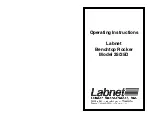
8
ENTER
5: COMPASS
5:1 INSTALLING THE SENSOR.
The sensor measures the direction of the Earth’s weak magnetic field, and so is
sensitive to other magnetic fields which can affect the unit’s accuracy. It should
therefore be positioned carefully. Select a position as far as possible away from
large ferrous objects such as engines, and items such as DC motors or loud-
speakers which have powerful permanent magnets in them. Check also for small
ferrous objects close to the mounting location such as screws, nails, hinges etc.
These can become magnetised and cause errors. When a likely location has
been found, a check for reasonable accuracy can be made with a hand bearing
compass to confirm its suitability.
The magnetic sensor itself is gimballed within the housing. To accommodate
pitch and roll motions most effectively, mount the sensor as near to horizontal as
possible. For best performance in rough weather conditions, it is also advisable
to mount the sensor in a position (usually amidships) that minimises lateral
accelerations due to pitch and roll. Avoid mounting the sensor high above the
water line because doing so also increases pitch and roll accelerations. The sen-
sor is waterproof to CFR-46 standard. Ensure the sensor does not become sub-
merged.
Position the sensor and mark and drill pilot holes for the mounting screws to
allow the sensor to be rotated to align it exactly with the vessel’s axis. Now
mount the sensor carefully in position using non-magnetic screws. The rotational
position of the sensor should be chosen to ensure that the arrow points as close
as possible fore-and-aft.
5:2 CONNECTING THE DISPLAY
Figure 1
ENTER
Cruiser
COMPASS
ALARM
BLEEPER






































